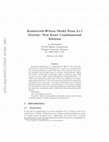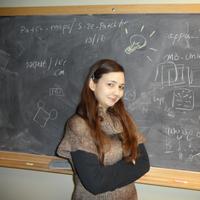Papers by Arkady Kholodenko
arXiv (Cornell University), Mar 27, 2023
Physical Review Letters, 1993

Physical Review E, 1995
The cooperative diffusion coefficient D, for spherical particle suspensions is calculated using a... more The cooperative diffusion coefficient D, for spherical particle suspensions is calculated using a "mode-coupling" method which extends previous calculations of D, for critical fluids and semidilute polymer solutions. The renormalization of the viscosity in the velocity-velocity correlation function from the solvent to the suspension viscosity leads to a generalized Stokes-Einstein (SE) equation in which the suspension viscosity ti replaces the solvent viscosity go and the correlation length g (related to the osmotic compressibility) replaces the sphere radius R at nonvanishing suspension concentrations. Insertion of the leading order hard sphere virial expansions for g and the osmotic compressibility into our generalized SE equation gives a virial expansion for D, which is consistent with theoretical estimates obtained by alternative methods. These leading order virial expansions are also consistent with experiments on model ("hard sphere") suspensions. Results are given for the virial expansion of spherical liquid droplets interacting via a contact attractive interaction. Further experiments are required to test the generalized SE equation at higher suspension concentrations.

Macromolecular Theory and Simulations, 1996
The persistence length I, of a polyelectrolyte chain can be represented as I, = I, + I, where I, ... more The persistence length I, of a polyelectrolyte chain can be represented as I, = I, + I, where I, is the bare persistence and I, is the electrostatic contribution coming from the effects of electrostatic chain self-interactions. Using a reparametrization-invariant path integral model of semiflexible polymers we find that I, depends on the ionic strength Z as I,-Z-"2. This result accords with experimental observations and recent Monte Carlo simulations. Reparametrization-invariance is apparently an essential constraint in selecting acceptable models of semiflexible polymers. The Kratky-Porod (K-P) model is widely utilized for the description of conformational properties of semiflexible chains ' 1. The basic feature of this model is that the tangent-tangent (t-t) correlator for the K-P chain is an exponential, exp (-I r I / l ,) , where T is the contour distance along the polymer chain and the "persistence length" I, is the rigidity correlation length. The second moment, i. e., the end-to-end distance (R2> of the K-P chain is determined by integrating the t-t to obtain the well known result, (R2> = 21: 01-1 + exp(-y)) wherey = N/Ip and N i s the total contour length of the chain. Not all conformational properties of semiflexible chains can be calculated using the K-P model however. For instance, there are no known closed form expressions for the moment generating function, the static scattering form factor S(k), etc. 2, Under these circumstances it is difficult to assess the adequacy of the K-P model for describing real polymers. Noticing that for y + 1 the limiting K-P result for (R2) = 21,Ncoincides with that known for fully flexible chains, it i s natural to assume that the K-P propagator describes simple random walk paths, at least in this limit. Following Polyakov's observation3) that "while in the bosonic case we have a Brownian path with its size R

Journal of Geometry and Physics, 2002
In previous publications (J. Geom.Phys.38 (2001) 81-139 and references therein) the partition fun... more In previous publications (J. Geom.Phys.38 (2001) 81-139 and references therein) the partition function for 2+1 gravity was constructed for the fixed genus Riemann surface.With help of this function the dynamical transition from pseudo-Anosov to periodic (Seifert-fibered) regime was studied. In this paper the periodic regime is studied in some detail in order to recover major results of Kontsevich (Comm.Math.Phys. 147 (1992) 1-23) inspired by earlier work of Witten on topological two dimensional quantum gravity.To achieve this goal some results from enumerative combinatorics have been used. The logical developments are extensively illustrated using geometrically convincing figures. This feature is helpful for development of some non traditional applications (mentioned through the entire text) of obtained results to fields other than theoretical particle physics.











Uploads
Papers by Arkady Kholodenko